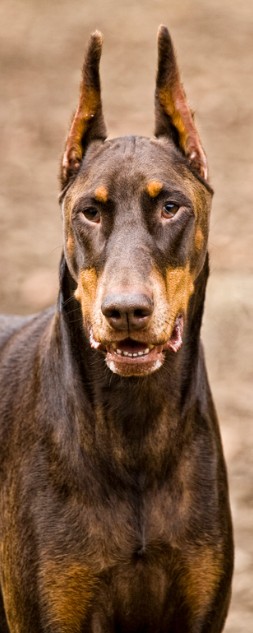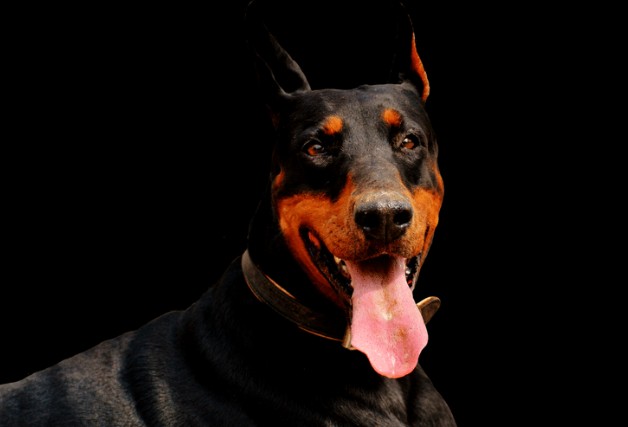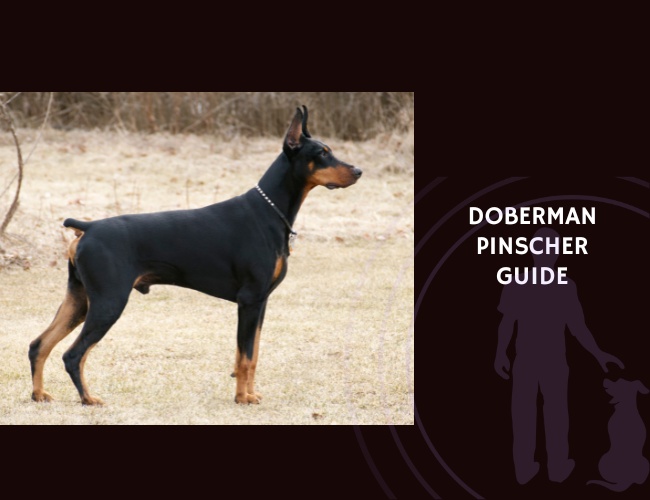Introduction to the Doberman Pinscher
A Working Legacy
The Doberman Pinscher was first bred in Germany in the late 1800s by Karl Friedrich Louis Dobermann, a tax collector looking for the perfect protection dog. By combining several breeds known for their courage, intelligence, and loyalty, he created a vigilant canine companion with a strong work ethic. This breed quickly earned a reputation for excellence in jobs such as police work, guarding, and search and rescue. Even today, Dobermans excel as working dogs, trusted by families and professionals for their instinct to protect and serve.
Distinctive Physical Features
Dobermans are unmistakable thanks to their athletic build and noble appearance. Their short, sleek coat comes in black, red, blue, or fawn, often with distinct rust markings. Standing between 61cm to 71cm at the shoulder and weighing anywhere from 27kg to 40kg, they pack both elegance and power. Their deep chest, muscular frame, and alert stance show off their physical capabilities. You’ll also notice their sharply defined head, long neck, and expressive, almond-shaped eyes that reveal their intelligence and intensity. Dobermans have short, thin fur, making them less tolerant of cold weather—something to keep in mind for their comfort indoors.
Guide Highlights and What to Expect
This guide is designed to support potential and current Doberman owners alike. We’ll cover behavior, training, nutrition, health, exercise, and living needs—all tailored to help you provide the best life for your Doberman. Each chapter is structured to be informative, professional, and supportive, offering digestible advice and highlighting key facts in a compassionate way. Whether you’re a first-time owner or a Doberman fan, you’ll find practical guidance to navigate each stage of your dog’s life. 🐾
As you move forward, you’ll grow to understand not just their history or looks, but the heart and mindset that make the Doberman truly remarkable.
Character & Behavioral Traits
Vigilance and Handler Orientation
The doberman pinscher stands out with strong vigilance. This means they are always alert and quick to notice new people or changes in their environment. Their roots as protection dogs make them naturally attentive and purposeful in their actions. Dobermans also form deep bonds with their main caregivers, often choosing a favorite person to follow closely 👀. This intense handler orientation can be great for teamwork, whether during training or daily routines.
Emotional Sensitivity
Dobermans have high emotional sensitivity. They pick up on their handler’s mood and body language easily. Because of this, they need stable, gentle guidance. Sudden changes or inconsistent rules may confuse them and lead to stress. Dobermans clearly show signs when they are anxious—such as pacing or whining—so it’s important for owners to watch for these signals and offer comfort and consistency.
The Socialized Doberman: Strengths
With proper socialization, dobermans shine. They display:
- Controlled assertiveness, showing confidence but not unnecessary aggression
- Loyalty to their family, forming strong, loving connections
- Protective instincts that stay within healthy boundaries
A well-socialized doberman is attentive but not overly suspicious. Early exposure to various people and situations helps shape their confidence. This makes them reliable, friendly companions who can tell who is a friend and who might be a threat.
Potential Behavioral Challenges
Like any breed, dobermans face some behavioral risks. If not guided and properly socialized, they may develop:
- Fear-aggression: reacting defensively if they feel threatened or scared
- Hypervigilance: being too watchful, which can make them anxious or restless
- Resource guarding: using growls or snaps to protect their toys or food
Understanding these tendencies is key to managing them. A calm home environment, steady training, and clear communication can help ensure your doberman thrives as a balanced companion 🦴.
Ready to help your doberman grow into a confident, happy adult, let’s focus on nurturing positive experiences from the very start.
Early Socialization: Building a Balanced Doberman
The Vital Early Months
Socializing a young doberman is not just important—it is essential for a balanced, confident adult dog. Early weeks and months shape their response to the world. Proper socialization helps them trust unfamiliar people, animals, and environments, setting the stage for healthy confidence rather than fear or reactivity.
Exposure to the World
Dobermans are highly responsive and emotionally sensitive. Early exposure to different sights, sounds, scents, and textures helps them become resilient. This includes trips outside, meeting a variety of friendly people, gentle dogs, and being introduced to common household noises. Short, positive outings—like walks to the park or visits to the pet store—are fantastic for building social skills and reducing the risk of neophobia (fear of new things) later in life.
Preventing Fear-Based Behaviors
Socialization is crucial to combat defensive responses. Without positive exposure, dobermans may show fear-aggression or become overly watchful of strangers. Regularly rewarding calm behavior around new people and places helps them associate new experiences with good things.
- Suggestions for early socialization:
- Use praise and treats at every new encounter
- Avoid forcing interaction—let your puppy set the pace
- Introduce various surfaces like grass, tile, and carpet
- Expose your doberman to hats, umbrellas, and loud vehicles
Keeping Socialization Positive
The goal is to create only safe, controlled social opportunities. Never overwhelm or punish a puppy for being fearful. This backfires, making anxiety worse. Instead, focus on patience and structured learning.
By investing in consistent, thoughtful socialization, you give your doberman the best possible start. A socially confident puppy grows into an adaptable, friendly adult, ready for successful training and happy experiences.

Training Approaches for Dobermans
Understanding Their Unique Learning Style
Dobermans stand out for their high drive and emotional sensitivity. These qualities make them intelligent and eager to learn but also mean they need training methods that respect their feelings. A Doberman’s loyalty and openness to their handler make positive, structured training especially effective and help build trust.
Operant Conditioning and Consistent Reinforcement
Operant conditioning—using rewards to reinforce desired behaviors—is one of the best ways to train a Doberman. They respond well to clear signals paired with praise, treats, or play. Consistency is key: reward your Doberman each time they perform correctly to help the lesson stick.
Some helpful reinforcement tips:
- Use small treats or favorite toys 🌟
- Keep training sessions short—about 15 minutes—to prevent frustration
- Mark good behavior clearly with a cue like “yes!”
- Pair new commands with hand signals for better understanding
Dobermans prefer structured routines. They need a training plan that includes regular sessions and step-by-step guidance. This approach helps them stay focused and prevents confusion.
Avoiding Harsh Corrections
Due to their sensitivity, harsh corrections can backfire. Scolding or physical punishment may cause stress or even defensive reactions. Instead, guide your Doberman gently when they make mistakes—redirect them to the correct behavior and praise their efforts.
Remember:
- Keep your tone calm and encouraging
- Ignore minor mistakes, but reward even small successes
- Provide a safe space during training to boost confidence 🧡
Supporting your Doberman with patient, positive methods will help them blossom into confident, cooperative companions. With a solid foundation in training, they are ready to explore activities and enrichment that keep them happy and mentally sharp.
Activities and Mental Stimulation
Keeping Minds and Bodies Engaged
Dobermans are intelligent and high-energy companions who thrive on activity and purpose. Engaging them in structured games and training can transform their alertness and work drive into positive outlets. Here are some top activities for these versatile dogs:
- Tracking: Following scent trails taps into their keen noses and sharp focus. This activity offers both physical exercise and a rewarding mental challenge.
- Protection sports: Sports like IGP (international working dog trials) offer safe, structured ways to channel the Doberman’s natural protective instincts while nurturing teamwork with their handler.
- Obedience training: Advanced obedience routines give Dobermans new things to learn and ways to shine.
- Scent work: Finding hidden scents exercises their brains and fulfills their need for problem-solving.
Challenging Exercises for Fulfillment
Dobermans need more than just a walk around the block. When they get daily chances to think and move, they are happier and less likely to develop problem behaviors like barking or chewing.
- Rotate different activities, for example, a day of tracking, followed by obedience games or an extended fetch session.
- Aim for exercises that require focus, like agility or puzzle toys. These not only improve physical health but also tire out their busy minds.
Why Mental Stimulation Matters
Without enough to do, Dobermans can quickly become bored or anxious. This boredom may lead to unwanted behaviors, such as digging or excessive barking. Regular mental challenges are just as important as physical ones to help your Doberman stay balanced and confident.
Structured activities set your dog up for success and promote a trusting relationship between you both. A happy Doberman is an engaged Doberman—one ready for whatever comes next. 😊
Loyal. Driven. Uncompromising.
Born to protect.
A Doberman doesn’t guess—he calculates. Every move is purposeful. Every look is a scan. Loyalty is not just a trait; it’s built into their design. They don’t guard out of fear. They guard out of duty.
Focused but feeling.
They read you like a page. Your tone, your posture, your silence—it all registers. Dobermans don’t just listen; they anticipate. Give them clarity, and they’ll return it with certainty.



Power meets principle.
Their strength isn’t reckless—it’s regulated. With the right leadership, that intensity becomes balance. Without it, that same intensity becomes chaos. Dobermans don’t need domination. They need direction.
Nutrition and Dietary Needs
Building Blocks for Health and Strength
A Doberman Pinscher’s diet needs to do a lot more than just satisfy hunger. To keep up with their high energy and athletic build, focus on balanced nutrition that supports lean muscle, healthy joints, and a strong heart. 🥩
- Proteins: Quality animal protein supports muscle growth and repair, especially important for active adults and growing pups.
- Carbohydrates: Simple and complex carbs provide the energy needed for daily activities, training, and playtime.
- Vitamins and minerals: These aid overall immune function, metabolism, and healthy skin.
Protecting Their Heart and Joints
Dobermans are at risk for heart problems such as dilated cardiomyopathy. For heart health:
- Ensure the diet is rich in taurine—an amino acid important for cardiac muscle.
- Provide heart-healthy fatty acids like Omega-3s from fish oils or flaxseed oil. These can help support cardiovascular function and maintain a glossy coat.
- Supplements for joint health—like glucosamine and chondroitin—can assist in keeping their active bodies moving comfortably. 🦴
Structured Feeding for Safety
With deep chests, Dobermans are susceptible to gastric dilatation-volvulus (GDV), also known as bloat. To help reduce risk:
- Feed two or three smaller meals per day instead of one large meal.
- Maintain a regular schedule and keep excitement low during meal times.
- Use slow feeders or puzzle bowls to prevent gulping.
A Doberman’s nutritional needs may change with age, activity, and health. Regular check-ins with your veterinarian ensure your dog’s diet stays on track and supports a long, joyful life. Regular review of weight and energy helps adjust portions and prevent obesity.
Meeting their dietary needs sets your Doberman up for strength and vitality—ensuring they have the energy and drive to thrive every day. 🐾
Health Concerns and Preventative Care
Common Health Challenges
Doberman Pinschers are intelligent and active, but they can face some notable health concerns. The most significant is dilated cardiomyopathy (DCM)—a heart condition where the heart becomes enlarged and weak, affecting its ability to pump blood. Sadly, DCM is often breed-specific and can be progressive.
Another challenge is cervical vertebral instability, also called Wobbler syndrome. This affects the spine in the neck, leading to a wobbly walk or even weakness in the back legs. Dobermans also have a higher risk of hypothyroidism, which is when the thyroid gland does not create enough hormones. This can cause tiredness, weight gain, and skin issues. Other concerns to be mindful of include hip dysplasia, gastric dilatation-volvulus (bloat), and chronic skin problems.
Role of Screening and Early Detection
Preventative care is the key to long, healthy lives for Dobermans. Genetic screening can help spot risks before problems start. Cardiac monitoring, such as regular heart checks, is important for catching DCM early. Testing for thyroid function and looking for symptoms of neck problems can help with early treatment and management.
- Regular veterinary visits
- Genetic tests before breeding
- Echocardiograms and blood tests
Everyday Preventative Steps
Owners can take action to help prevent or catch health problems:
- Feed a diet that is balanced and supports heart and joint health.
- Keep a regular exercise schedule.
- Watch for changes in behavior, energy, or movement.
- Split meals into smaller portions to help prevent bloat.
- Partner with veterinarians for yearly checks and prompt attention to issues.
Caring for a Doberman’s health means being proactive, compassionate, and dedicated. With the right steps, you give your dog the best chance for a long, happy life. 🐾

Exercise Requirements and Physical Needs
How Much Exercise Does a Doberman Need?
Doberman Pinschers are energetic dogs who require at least 90 minutes of daily physical activity to remain healthy and happy. Consistency is crucial—these dogs thrive on a predictable routine. Without sufficient movement, Dobermans may develop anxiety or display restless, unwanted behaviors. An engaging walk, a run, or structured play every day provides the foundation for a balanced, content companion.
Mixing Physical and Mental Exercise
Dobermans need more than just a walk around the block! To prevent boredom and boost well-being, combine aerobic activities with brain games. Here are a few ideas:
- Brisk walks and jogging
- Tug-of-war or fetch
- Agility drills or simple obstacle courses
- Scent work or hide-and-seek with toys
- Short training sessions involving obedience or trick commands
Mental stimulation is essential, and even short puzzle sessions help keep their sharp minds focused and calm. 😊
Age-Appropriate Exercise Adjustments
Puppies and senior Dobermans need special care when it comes to exercise.
- Puppies: Avoid high-impact activities to protect developing joints. Use several short play periods spread throughout the day.
- Adults: Ensure a good balance of active play and challenging tasks. This is their prime for movement and skill-building.
- Seniors: Keep up regular walks, but shorten durations as needed. Gentle games and slow-paced activities help maintain fitness without causing stress.
Regular adaptation ensures the Doberman’s exercise plan supports their physical and mental health at any age. When their bodies and brains are fulfilled, Dobermans settle into home life far more easily.
Ready to discover how a loving home environment shapes daily life with a Doberman? 🏡
Living with a Doberman: Home Environment
Creating Stability and Consistency
Dobermans thrive on order and predictability in their home life. Setting a consistent daily routine—like regular feeding times, walks, and bedtime—helps your dog feel secure and reduces anxiety. These intelligent canines pick up on household rhythms quickly, but sudden changes or irregular patterns can make them uneasy.
To support their well-being:
- Keep mealtimes, exercise sessions, and play periods at the same time each day.
- Offer a quiet space where your Doberman can retreat and relax.
- Limit changes in the environment when possible, especially during their adjustment phase.
Early Boundary Setting and Environmental Management
Dobermans respond best when boundaries are clear from day one. Start by establishing which areas are off-limits and where your pup can play, rest, or explore. Use gates and positive redirection—rewarding the correct behavior instead of punishing mistakes. This supports their need for guidance without causing fear.
Environmental enrichment matters too:
- Rotate toys and introduce safe chew items.
- Give structured freedom, slowly expanding access as your Doberman learns rules.
- Always supervise during the first months to prevent unwanted habits.
Indoor Living and Cold Tolerance
While Dobermans are energetic, they are not suited to outdoor-only living. Their short coat and low body fat make them sensitive to cold 🥶. Indoors, provide a cozy bed away from drafts and consider a dog sweater for chilly walks.
Practical tips:
- Never leave your Doberman outside in cold weather for long periods.
- Use rugs or mats on slippery floors to prevent injury.
- Keep your home warm and emotionally safe—a happy Doberman is one who feels like a true part of the family.
With intentional routines and mindful boundaries, you create a nurturing space for your Doberman to thrive, setting the stage for positive family integration and companionship.
The Doberman as a Family Dog
Building Strong Bonds with the Family
Doberman Pinschers are deeply loyal and connect strongly with their family members. They thrive in homes where every person has a clear and positive relationship with them. Setting roles from the start helps avoid confusion and ensures your Doberman feels secure in their place in the family.
- Encourage every family member to participate in daily routines like walks, playtime, and feeding.
- Use consistent rules and cues so your Doberman knows what to expect.
- Dobermans can become stressed if they sense tension at home, so open communication benefits both the humans and the dog.
Supervision and Education Around Children 👶🐾
Dobermans can be gentle companions for children when properly introduced and supervised. Their protective nature means they are alert, but guidance is essential:
- Always supervise play sessions between Dobermans and young children.
- Teach children how to approach, pet, and play calmly—no chasing or rough games.
- Dobermans appreciate structure, so create routines children can share with the dog, such as helping with feeding or short training exercises.
Living with Other Pets
With correct introductions and boundaries, Dobermans can coexist peacefully with other pets. Remember, their instinct to guard may be strong:
- Begin introductions on neutral ground and keep early meetings calm and positive.
- Supervise interactions until trust is established.
- Reinforce friendly, relaxed behavior and separate pets if there is any tension over resources like food or toys.
Over time, a Doberman that receives thoughtful guidance and positive reinforcement can become a loving, safe, and joyful member of the household. This sets the foundation for lifelong harmony and trust.
Conclusion: Is a Doberman Right for You?
Understanding the Commitment 🐾
Owning a Doberman Pinscher is both exciting and demanding. This breed needs more than basic care—they require regular training, daily exercise, and attentive healthcare. A Doberman needs at least 90 minutes of physical activity every day, along with challenging tasks that engage their minds. Early socialization and clear routines are vital. Dobermans do best with handlers who set structure and provide reliable affection, as these intelligent dogs thrive on consistent boundaries and emotional support.
Ideal Owner Qualities
Is your lifestyle right for a Doberman? These dogs need owners who are:
- Ready to invest time in socialization and training
- Able to provide routine and predictability
- Committed to daily, energetic activities
- Comfortable with a dog who attaches strongly and follows closely
- Understanding of health needs, including heart and joint care
Dobermans are not suited for families who are away from home for long hours or who lack clear house rules. Consistency is key—chaotic or unpredictable environments can leave these sensitive dogs feeling anxious or uncertain.
Rewards of Doberman Companionship ❤️
Living with a Doberman means enjoying:
- Deep loyalty and family bonding
- Keen protection and intuitive alertness
- Eager participation in activities and sports
- Unmatched companionship and affection
With the right match, a Doberman becomes more than a pet—they become a trusted family member, ready to share in your daily adventures and provide steadfast love. Taking the time to understand their unique needs ensures a strong, rewarding relationship built on trust and mutual respect.










